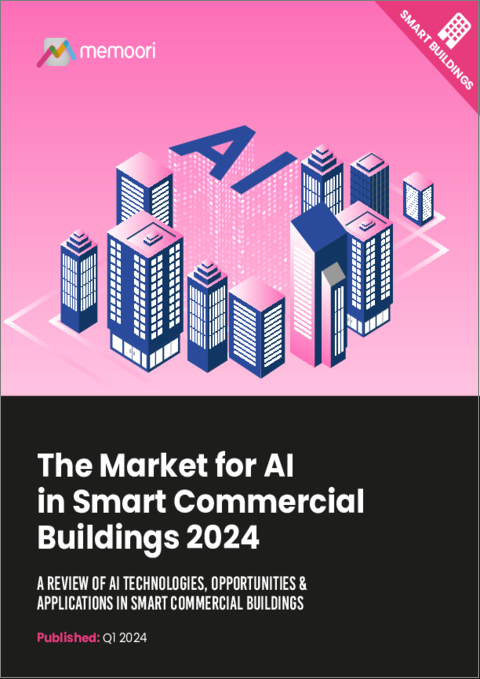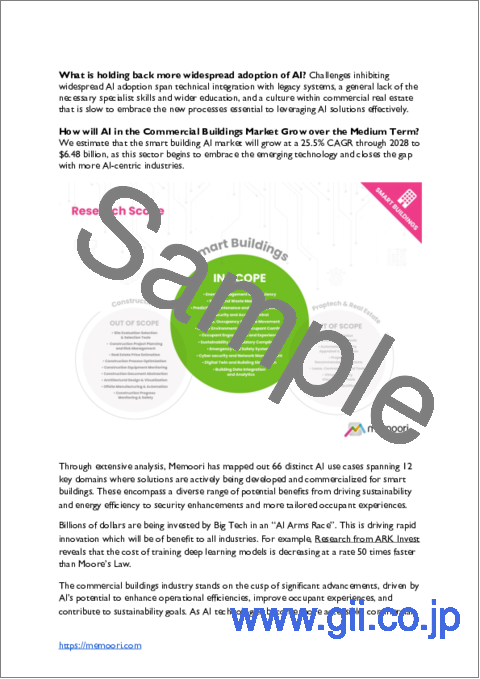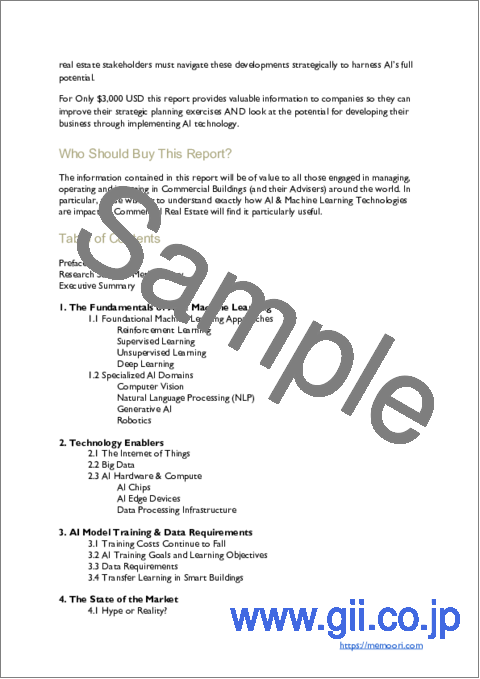|
|
市場調査レポート
商品コード
1448836
スマート商業ビルにおけるI人工知能 (AI) の世界市場 :2024年The Market for AI in Smart Commercial Buildings 2024 |
||||||
|
|||||||
| スマート商業ビルにおけるI人工知能 (AI) の世界市場 :2024年 |
|
出版日: 2024年03月11日
発行: Memoori
ページ情報: 英文 Spreadsheet, 164 Pages, 18 Charts, Presentation Slides
納期: 即日から翌営業日
|
全表示
- 概要
- 図表
- 目次
当レポートは、商業ビル市場における人工知能 (AI) の役割の拡大について調査する、2024年時点での最新分析です。
この最新分析は、Memooriの2021年の人工知能 (AI) 市場分析をベースとして、よりスマートで持続可能性・応答性のより高い建築環境を実現させる、AIの全般的な能力と専門的用途の両方で生じた変化に注目して分析します。
当レポートは2部構成のレポートシリーズの第1弾であり、AI市場の展望に関する第2弾は今年後半に発行される予定です。 どちらのレポートも、当社の2024年度のPremium Subscription Serviceに含まれており、大規模言語モデル (LLM) を活用して当社の全ての分析レポートが検索可能な、当社のChatbot AIM にもアクセスできます。
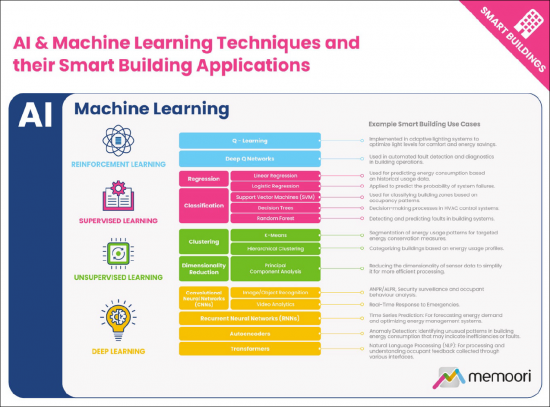
当レポートで回答している主な質問
- 我々は、"真のコグニティブ・ビルディング"に向かう段階のどこにいるのか? 今日の商業ビル技術は、ルールベースの分析からAI予測機械学習モデルへと移行しつつありますが、採用はまだ限定的レベルにとどまっています。実際の導入範囲は狭いままで、エネルギー最適化、スペース利用、セキュリティなどのよく理解されている範囲に留まっています。
- AIの広範囲への普及を阻むものは何か?AIの普及を阻害している課題は、旧来のシステムとの技術的統合、必要な専門スキルや幅広い教育の不足、AIソリューションを効果的に活用するために不可欠な新しいプロセスを受け入れるのに時間がかかる商業不動産内の文化など、多岐にわたります。
- 商業ビル向けAI市場は、中期的にどのように成長するか?スマートビルAI市場は、2028年まで25.5%のCAGRで成長し、64億8,000万米ドルに達すると予測されています。
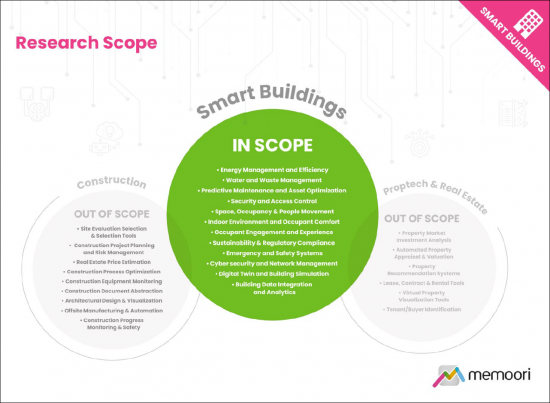
当レポートは164ページの文章と18点の図表で構成され、すべての重要な事実を抽出し、結論を導き出しているため、AI技術が商業ビルにどのように適用されるのか、またその理由を正確に理解することができます;
- Memooriでは広範な分析を通じて、66件の個別のAI使用事例を、12種類の主要ドメインに分類しています。各ドメインでは、ソリューションがスマートビルディング向けに積極的に開発・商業化されています。これらは、持続可能性やエネルギー効率の促進から、セキュリティの強化や居住者の体験のカスタマイズまで、多様な潜在的利益を包含しています。
- 大手テック企業により、数億米ドルの資金が「AI軍拡競争」に投資されています。これにより、あらゆる産業に利益をもたらす急速なイノベーションが推進されています。例えばARK Investの調査よると、ディープラーニングモデルの学習コストは、ムーアの法則の50倍の速さで減少しています。
- 商業ビルの業界は、業務効率の向上、居住体験の改善、持続可能性目標への貢献といったAIの可能性により、大きな進歩の端緒に立っています。AI技術がより身近になるにつれ、商業用不動産の利害関係者は、AIの可能性を最大限に活用するために、こうした発展を戦略的にナビゲートする必要があります。
当レポートは、企業が戦略立案を改善し、AI技術を導入することでビジネスを発展させる可能性を検討できるよう、貴重な情報を提供します。
目次
序文
調査範囲・手法
エグゼクティブサマリー
第1章 AI と機械学習の基礎
- 機械学習の基本的なアプローチ
- 強化学習
- 教師あり学習
- 教師なし学習
- 深層学習 (ディープラーニング)
- AIの専門領域
- コンピュータビジョン
- 自然言語処理 (NLP)
- 生成AI
- ロボット工学
第2章 テクノロジーの実現要因
- IoT (モノのインターネット)
- ビッグデータ
- AIハードウェアとコンピューティング
- AIチップ
- AIエッジデバイス
- データ処理インフラ
第3章 AIモデルのトレーニングとデータ要件
- 研修費用の継続的な低下
- AIトレーニングのゴールと学習目標
- データ要件
- スマートビルディングにおける転移学習
第4章 市場の現状
- 誇大広告か現実か?
- 一般的なAIの導入・投資の動向
- 業界別の導入率
- 地域による違い
- 投資動向
- 投資収益率 (ROI)
- 企業感情
- 主な使用事例と活用領域
- スマートビルディングの採用・投資の動向
- 採用指標
- 調査指標
- スマートビルディング用AIソリューションの成熟度評価
第5章 市場機会の規模評価
- AI市場予測のメタ分析
- AIによる利益の評価
- 地域別の市場分析
- スマートビルディング市場の予測
第6章 活用領域と使用事例
- スマートビルディングの使用事例:概要
- 使用事例のデータ入力へのマッピングとAI手法
- スマートビルディングの使用事例:市場の評価
- エネルギー管理と効率
- ドメインの概要
- 主な使用事例
- 水道・下水管理
- 予知保全・資産最適化
- セキュリティ・アクセス制御
- 空間・空室・人員移動
- 室内環境・居住者の快適性
- 居住者のエンゲージメントと体験
- 持続可能性と規制コンプライアンス
- 緊急・安全システム
- サイバーセキュリティ・ネットワーク管理
- デジタルツイン・建築物シミュレーション
- データインテグレーション・分析
第7章 市場の課題と抑制要因
- 老朽化インフラ
- ユーザーの信頼と信用
- AIの過大評価とマーケティング
- 解釈可能性
- 正確さと錯覚
- データ関連の課題
- 統合、相互運用性、オープンスタンダード
- データの所有権と管理
- データの品質
- データのプライバシー
- スキルギャップと人材育成
- 配置転換
- AIのエネルギー消費量
第8章 倫理上・規制上の考慮事項
- AIの安全性・倫理性・整合性
- 現在のAI規制とスマートビルディングへの影響
- AI規制・標準:世界各国での違い
- データのプライバシー
- AI規制状況はどのように進化するか
第9章 将来のシナリオとその意味
- AGI (汎用人工知能) への道:現状について
- 生成型AIとインタラクティブ AIの新しい活用領域
- AIエージェント
- AIaaS (「サービスとしての」AI)
- アクセシビリティ、民主化、オープンソース AI
List of Charts and Figures
- Fig 1.0 - Research Scope
- Fig 1.1 - AI & Machine Learning Techniques and their Smart Building Applications
- Fig 2.1 - Installed Base of IoT Devices in Commercial Smart Buildings 2020 to 2028
- Fig 4.1 - Global Corporate Investment in AI by Type 2013 to 2022
- Fig 4.2 - AI Mentions in S&P 500 Earnings Calls Q3 2018 to Q3 2023
- Fig 4.3 - The Leading Applications for AI Deployments, % of Respondents
- Fig 4.4 - Real Estate Firm Engagement with AI Solutions in 2023
- Fig 4.4 - The Gap between Expected Impacts & Knowledge Levels for AI Real Estate
- Fig 4.5 - Trends in Smart Buildings & AI Research 2015 to 2023
- Fig 4.6 - Prescriptive Data's Model of AI Solution Maturity
- Fig 4.7 - Smart Building Solution Maturity
- Fig 5.1 - Global AI Market Forecasts, A Meta-Analysis 2019 to 2030
- Fig 5.2 - The Global Market for AI in Smart Commercial Buildings 2020 to 2028, $ Billions
- Fig 6.1 - AI & Machine Learning Use Cases in Smart Commercial Buildings
- Fig 6.2 - AI's Energy-saving Potential by Application Area, Energy Saving Effect %
- Fig 7.1 - Leading Barriers Hindering Enterprise AI Adoption %
This Report is a New 2024 Study that Explores the Growing Role of Artificial Intelligence within the Commercial Buildings Market.
This new research builds on Memoori's 2021 Artificial Intelligence (AI) market analysis and looks at the progress that has occurred both in the capabilities of AI broadly and its specialized applications enabling smarter, more sustainable, and more responsive built environments.
It includes, at no extra cost, a spreadsheet containing the data from the report and high-resolution presentation charts showing the key findings. It is the first in a 2-part series of reports, with the second report on the AI market landscape being published later this year. Both these reports are included in our 2024 Premium Subscription Service, which also gives access to our chatbot AIM, where you can query all our research using the power of Large Language Models (LLMs) .

KEY QUESTIONS ADDRESSED:
- Where are we on the journey towards "truly cognitive buildings"? Today's commercial buildings technology is transitioning away from rules-based analytics towards AI predictive machine learning models but adoption remains at modest levels. Real-world deployments remain narrow in scope driven by the more well-understood use cases around energy optimization, space utilization, and security.
- What is holding back more widespread adoption of AI? Challenges inhibiting widespread AI adoption span technical integration with legacy systems, a general lack of the necessary specialist skills and wider education, and a culture within commercial real estate that is slow to embrace the new processes essential to leveraging AI solutions effectively.
- How will AI in the Commercial Buildings Market Grow over the Medium Term? We estimate that the smart building AI market will grow at a 25.5% CAGR through 2028 to $6.48 billion, as this sector begins to embrace the emerging technology and closes the gap with more AI-centric industries.

WITHIN ITS 164 PAGES AND 18 CHARTS AND TABLES, THE REPORT FILTERS OUT ALL THE KEY FACTS AND DRAWS CONCLUSIONS, SO YOU CAN UNDERSTAND EXACTLY HOW AI TECHNOLOGY WILL BE APPLIED TO COMMERCIAL BUILDINGS AND WHY;
- Through extensive analysis, Memoori has mapped out 66 distinct AI use cases spanning 12 key domains where solutions are actively being developed and commercialized for smart buildings. These encompass a diverse range of potential benefits from driving sustainability and energy efficiency to security enhancements and more tailored occupant experiences.
- Billions of dollars are being invested by Big Tech in an "AI Arms Race". This is driving rapid innovation which will be of benefit to all industries. For example, Research from ARK Invest reveals that the cost of training deep learning models is decreasing at a rate 50 times faster than Moore's Law.
- The commercial buildings industry stands on the cusp of significant advancements, driven by AI's potential to enhance operational efficiencies, improve occupant experiences, and contribute to sustainability goals. As AI technologies become more accessible, commercial real estate stakeholders must navigate these developments strategically to harness AI's full potential.
This report provides valuable information to companies so they can improve their strategic planning exercises AND look at the potential for developing their business through implementing AI technology.
WHO SHOULD BUY THIS REPORT?
The information contained in this report will be of value to all those engaged in managing, operating and investing in Commercial Buildings (and their Advisers) around the world. In particular, those wishing to understand exactly how AI & Machine Learning Technologies are impacting Commercial Real Estate will find it particularly useful.
Table of Contents
Preface
Research Scope & Methodology
Executive Summary
1. The Fundamentals of AI & Machine Learning
- 1.1. Foundational Machine Learning Approaches
- Reinforcement Learning
- Supervised Learning
- Unsupervised Learning
- Deep Learning
- 1.2. Specialized AI Domains
- Computer Vision
- Natural Language Processing (NLP)
- Generative AI
- Robotics
2. Technology Enablers
- 2.1. The Internet of Things
- 2.2. Big Data
- 2.3. AI Hardware & Compute
- AI Chips
- AI Edge Devices
- Data Processing Infrastructure
3. AI Model Training & Data Requirements
- 3.1. Training Costs Continue to Fall
- 3.2. AI Training Goals and Learning Objectives
- 3.3. Data Requirements
- 3.4. Transfer Learning in Smart Buildings
4. The State of the Market
- 4.1. Hype or Reality?
- 4.2. General AI Adoption & Investment Trends
- Adoption Rates Across Industries
- Regional Variations
- Investment Trends
- Returns on Investment
- Corporate Sentiment
- Leading Use Cases and Applications
- 4.3. Smart Building Specific Adoption & Investment Trends
- Adoption Indicators
- Research Indicators
- 4.4. Assessing Smart Building AI Solution Maturity
5. Sizing the Opportunity
- 5.1. A Meta Analysis of AI Market Forecasts
- 5.2. Assessing the Gains Attributable to AI
- 5.3. Geographic Market Analysis
- 5.4. Smart Building Market Estimates
6. Applications & Use Cases
- 6.1. An Overview of Smart Building Use Cases
- Mapping Use Cases to Data Inputs & AI Techniques
- 6.2. Evaluating Smart Building Use Case Markets
- 6.3. Energy Management and Efficiency
- Domain Overview
- Key Use Cases
- 6.4. Water and Waste Management
- Domain Overview
- Key Use Cases
- 6.5. Predictive Maintenance and Asset Optimization
- Domain Overview
- Key Use Cases
- 6.6. Security and Access Control
- Domain Overview
- Key Use Cases
- 6.7. Space, Occupancy & People Movement
- Domain Overview
- Key Use Cases
- 6.8. Indoor Environment and Occupant Comfort
- Domain Overview
- Key Use Cases
- 6.9. Occupant Engagement and Experience
- Domain Overview
- Key Use Cases
- 6.10. Sustainability & Regulatory Compliance
- Domain Overview
- Key Use Cases
- 6.11. Emergency and Safety Systems
- Domain Overview
- Key Use Cases
- 6.12. Cybersecurity and Network Management
- Domain Overview
- Key Use Cases
- 6.13. Digital Twin and Building Simulation
- Domain Overview
- Key Use Cases
- 6.14. Data Integration and Analytics
- Domain Overview
- Key Use Cases
7. Challenges & Market Barriers
- 7.1. Legacy Infrastructure
- 7.2. User Confidence & Trust
- AI Overhype and Marketing
- Interpretability
- Accuracy & Hallucination
- 7.3. Data Related Challenges
- Integration, Interoperability & Open Standards
- Data Ownership & Control
- Data Quality
- Data Privacy
- 7.4. Skills Gaps and Workforce Development
- 7.5. Job Displacement
- 7.6. The Energy Consumption of AI
8. Ethical & Regulatory Considerations
- 8.1. AI Safety, Ethics & Alignment
- 8.2. The Current State AI Regulations & Implications for Smart Buildings
- Global Variations in AI Regulations & Standards
- Data Privacy
- 8.3. How the AI Regulatory Landscape Might Evolve
9. Future Scenarios & Their Implications
- 9.1. Where Are We on the Road to AGI?
- 9.2. Emerging Applications for Generative AI & Interactive AI
- 9.3. AI Agents
- 9.4. AI as a Service
- 9.5. Accessibility, Democratization & Open-Source AI
